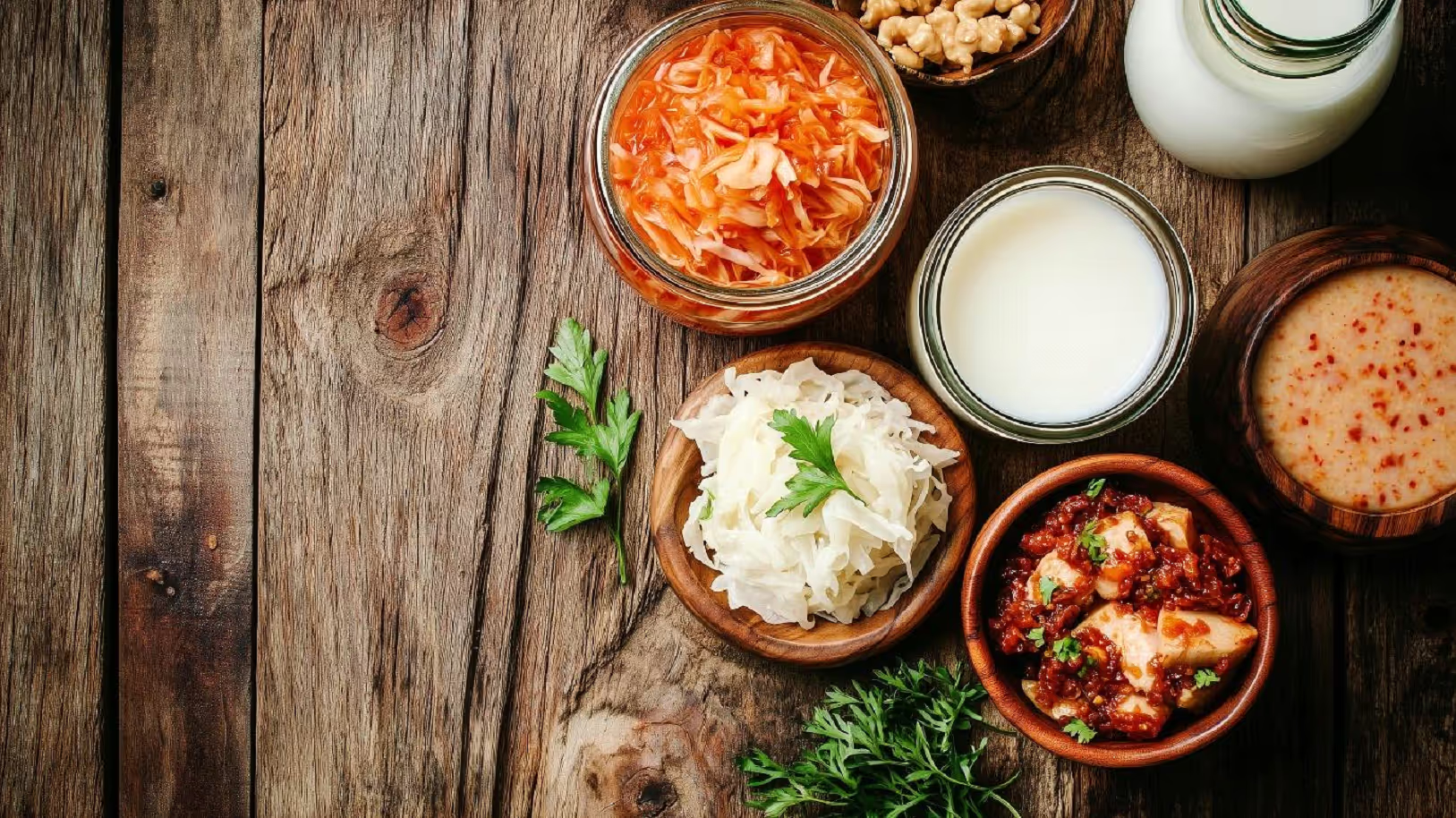
It becomes increasingly conscious of natural approaches to wellbeing, food with good bacteria are rising in popularity. These foods, rich in live microorganisms and beneficial bacteria, naturally carry microbes that can positively impact your health. They are not just nutritional fads—they’re deeply rooted in traditional practices and modern science. Whether you’re sipping on fermented tea drinks, enjoying a bowl of miso soup, or taking a spoonful of cultured buttermilk, you’re feeding your body more than just calories—you’re supplying it with friendly bacteria that can support your overall health in meaningful ways. Explore these foods, their types, their potential health benefits, and how to make them a natural part of your daily diet.
Food with good bacteria are those that naturally contain or are enriched with live bacteria—also called probiotics. These beneficial microbes are present in many traditional and modern food products and can provide positive effects on human health, especially when consumed regularly in adequate amounts.
These foods contain parts such as live cultures or active bacteria, which are responsible for their probiotic effects.
Probiotics are live microorganisms, primarily bacteria, that provide beneficial effects when taken through food or dietary supplements. The term active cultures refers to these living microbes still present in food at the time of consumption. Many products, such as yogurt and fermented foods, contain live and active cultures. The activity of these microbes during fermentation is what gives probiotic foods their unique health benefits.
Common probiotic bacteria belong to families like the Lactobacillus genus and Bifidobacterium, including strains such as:
Many probiotic foods and supplements use a combination of different strains to maximize health benefits, as specific combinations can provide enhanced effects compared to single-strain products.
Each specific strain has its own characteristics and potential health benefits, from supporting immune function to improving lactose intolerance tolerance in some individuals.
When it comes to natural sources of probiotic bacteria, kefir is often considered one of the most powerful options. This traditional fermented milk drink is made by adding kefir grains to milk, resulting in a smooth, tangy beverage packed with live and active cultures. Kefir is a fermented probiotic milk drink made by adding kefir grains to cow’s or goat’s milk.

Kefir can contain up to 30 unique probiotic strains, making it one of the most diverse probiotic foods available worldwide.
While all probiotic foods are fermented, not all fermented foods contain probiotic bacteria. The difference lies in whether the active cultures survive the production process and remain alive in the final product.
Information about live cultures is often presented on product labels to help consumers identify true probiotic foods.

Many fermented foods have been consumed for centuries in cultures across the globe, often valued for their flavour and preservative qualities:
Some fermented foods, such as tempeh and natto, are high-protein alternatives to meat, making them popular choices for those seeking plant-based or meat-like protein sources with added health benefits.
Kimchi is a fermented, spicy Korean side dish that usually includes cabbage as the main ingredient.
These foods often contain lactic acid bacteria, responsible for fermentation and flavour, and may also include live bacteria with beneficial properties.
Yoghurt is arguably the most accessible and widely consumed of all probiotic products. Whether made from cow’s, sheep’s, or goat’s milk, yoghurt with live and active cultures like Lactobacillus can offer important nutrients such as calcium, vitamin B12, and protein—while also introducing friendly bacteria into your diet.
Yoghurt with live cultures can also be used as a base for gut-friendly salads or dressings, providing a nutritious option to support digestive health.
Miso soup, a staple in Japanese cuisine, is made using fermented soybean paste. This paste contains lactic acid bacteria and other beneficial microbes that contribute to the health benefits of this savoury dish. It’s also a great source of various vitamins, including B vitamins and vitamin K. Miso is a Japanese seasoning made by fermenting soybeans with salt and a fungus called koji.
The beneficial microbes in miso can positively influence the balance of gut bacteria.
Kombucha, a fermented tea drink, is popular among health-conscious people. When unpasteurised and raw, it contains live bacteria and yeast, and may contribute beneficial effects such as increased antioxidant intake and a healthy immune system. Kombucha is a fermented black or green tea drink that contains various strains of bacteria and yeas.
Some people also drink kombucha to help manage stress and support gut health.
Though most of the probiotic bacteria are killed during baking, sourdough bread still offers benefits through the short chain fatty acids produced during fermentation. It’s often easier to digest and lower in gluten than commercial breads.
Pickles are cucumbers preserved in a solution of salt and water, left to ferment using their naturally present lactic acid bacteria.
If you’re not regularly eating probiotic foods, probiotic supplements can be a convenient way to consume certain probiotics in adequate amounts. However, as noted by experts at Harvard Medical School, taking probiotics without knowing the specific strain or purpose may be less effective.
When choosing a supplement, look for data on the effectiveness of specific strains for your health needs.
Always consult a healthcare professional before beginning supplementation, especially if you have existing health conditions.
The benefits of probiotic foods or supplements may depend on consistent use over several days or even weeks to achieve noticeable effects.
Food-first is the general rule among nutritionists. While dietary supplements can fill the gaps, foods rich in beneficial bacteria offer important nutrients, taste, and satiety—something other probiotics in capsule form may not provide.
However, while these benefits are promising, there is not enough evidence to support all health claims related to probiotics.

Products often have higher standards, so explore local options in grocery stores and health food shops.
It is also important to raise public awareness about the safety and quality of probiotic products, especially for vulnerable groups.
Incorporating these foods into your routine doesn’t have to be complicated:
Small, consistent choices can add up to meaningful improvements in how you feel.
Read more for easy recipes and tips on how to incorporate probiotic foods into your meals.
Including food with good bacteria in your diet is more than just a trend—it’s a sustainable, natural way to promote resilience, balance, and long-term wellness. From fermented soybeans to yoghurt and kefir grains, there’s a wide variety of probiotic foods available to suit every taste and preference.
Join The Hub community. Subscribe today and receive a monthly email with our newest blogs and articles on health, wellness, and nutrition to keep you informed and inspired.
By signing up you agree to our User Agreement and Privacy Policy & Cookie Statement

By accessing, browsing, or using this website (the “www.newimage.world/thehub”), you acknowledge and agree to the terms of this Disclaimer. The Website, including its blogs, podcasts, videos, and any other content (collectively, the “Content”), is operated by New Image™ International (“the Company,” “we,” “our,” or “us”).
All Content made available on this Website is provided strictly for general informational and educational purposes only. The Content does not constitute, and should not be relied upon as, medical advice, diagnosis, treatment, prescription, or professional health consultation of any kind.
The Company makes no representations or warranties regarding the accuracy, completeness, reliability, or timeliness of the Content. The Content may include information collected from external or third-party sources, and we do not independently verify such information. Accordingly, no nutritional, health, or wellness claims are endorsed, warranted, or guaranteed by the Company.
To the fullest extent permitted by applicable law:
Your use of the Website does not establish any doctor–patient, nutritionist–client, or other professional relationship between you and the Company or any of its representatives.
The Website may include references, links, or access to third-party websites, podcasts, or resources. The Company does not control, endorse, or assume any responsibility for such third-party content and shall not be held liable for any damages arising from your use of or reliance on it.
By clicking “Accept” on the Website’s pop-up disclaimer, you expressly acknowledge that you have read, understood, and agreed to be bound by this Disclaimer. Your continued use of the Website constitutes ongoing acceptance of these terms. If you no longer agree with this Disclaimer, you must immediately discontinue use of the Website.
Join The Hub community. Subscribe today and receive a monthly email with our newest blogs and articles on health, wellness, and nutrition to keep you informed and inspired.
By signing up you agree to our User Agreement and Privacy Policy & Cookie Statement
